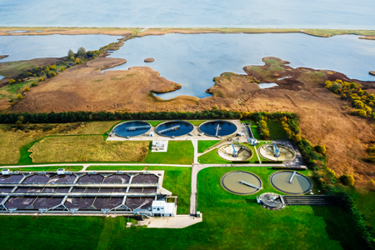The Water Sector's Role In The Race To Net Zero
By Frederikke Rørvang Mikkelsen

The water sector’s road to net zero is paved with significant challenges and great opportunities. However, a shortcut may be in sight if you scout across the Atlantic to Denmark, where the water sector is well on its way to becoming climate-positive in 2025 and energy-neutral by 2030.
Frequent and intense water events, such as droughts, flooding, and changes to rainfall patterns have become more and more visible around the globe — many of them as consequences of climate change. As 2 percent of the total U.S. energy consumption is used for drinking water and wastewater services, emitting more than 45 million tons of greenhouse gas (GHG) annually,1 there is no doubt that the water sector plays an essential role in decarbonization, lowering climate impacts, and mitigating new challenges related to efficient water management. However, many utilities struggle with the question, “Where to start?”
According to the nonprofit U.S. Water Alliance, one of the answers is net-zero targets. To identify the innovative, efficient, and affordable solutions to achieve these targets, the organization launched the initiative, The Imagination Challenge: Water’s Role in the Race to Zero, in 2021.
Katy Lackey, senior program manager at U.S. Water Alliance, explains that the core of the initiative is to bring together stakeholders in the water industry to foster collaboration and peer exchange. In this light, she explains that on the route to reaching net zero, the path could very well go through Denmark, since U.S. utilities increasingly look toward their Danish counterparts and their efforts of mitigating and lowering GHG emissions.
“As one of the first water sectors to set a net-zero water goal and support federal regulations, Denmark offers a strong model for taking this step,” Lackey mentions.
Climate-Positive By 2030: Energy Efficiency Is Key
The Danish water industry has already set targets for a climate-positive and energy-neutral water sector by 2030 — targets that support the Danish government’s strategy to reduce GHG emissions by 70 percent by 2030. Additionally, the government introduced a tracking framework to support the utilities’ ambition in limiting net energy use and reducing GHG emissions. Utilities can report voluntarily, and the first status report from 2021 shows that the sector is well on its way to becoming climate-positive already in 2025.2
Sofie Hyldal Thorgaard, a technical advisor at the Danish Water Technology Alliance in North America, explains that Danish solution providers and utilities have pushed the limits for operational efficiency for decades. Political incentives and regulation have also been vital drivers in the Danish model. Since 2011, the Danish water sector has been economically benchmarked and has had individual economic efficiency requirements. Today, the benchmark includes both OPEX and CAPEX measures, to compare the utilities on total economic efficiency3 (TOTEX). Additionally, performance benchmarks on various environmental factors and financial incentives to limit pollution and discharge of nutrients to levels even below regulatory limits are in force. As a result, these efforts have pushed the utilities to monitor and measure their operations in real time. This is where digitalization takes center stage.
“Collecting data is essential because you cannot manage what you cannot measure. In my experience, a utility can typically find 50 to 70 percent of energy savings by implementing digital solutions and measuring operations with an eye to real-time control,” Thorgaard states.
As part of Thorgaard’s position at the Danish Water Technology Alliance, an outreach program that works to bridge the gap between the Danish and U.S. water sectors, she spends a great deal of time visiting U.S. utilities. In her experience, the digitized approach to monitoring and control is something many water utilities and wastewater treatment plants (WWTPs) on this side of the Atlantic find inspiring, as it is an easy way to save not only energy — but also dollars.
“Most wastewater treatment plants spend approximately 54 percent of their total energy consumption on aeration. Utilizing variable frequency drives (VFDs) on the blowers and controlling air distribution remotely according to actual needs instead of a fixed setpoint saves both energy and money. Furthermore, it is a small exercise with a significant impact and a relatively short ROI,” Thorgaard explains.
She further adds that just as energy efficiency is at the core of the Danish path to becoming climate-positive five years ahead of schedule, efficient wastewater treatment and energy production are also inevitable parts of the solution. Lastly, Thorgaard points to the fact that producing energy from the sludge in the longer run also offers great savings on OPEX, as a typical WWTP spends 25 to 40 percent of its operating budget on electricity.
Wastewater — A Challenge Or Opportunity?
In Denmark, more than 90 percent of all wastewater is collected and treated. Furthermore, many utilities turn sludge from the process into energy, and a study by the Danish Environmental Protection Agency shows that the Danish wastewater sector produced two-thirds of the amount of energy it used to transport and treat wastewater in 2018. Some even produce enough electricity to supply the entire water stream from groundwater harvest to distribution and wastewater treatment from a WWTP’s perspective.
You can find one of these utilities in Aarhus, the second largest city in Denmark, as it achieved 150 percent energy self-sufficiency in 2020. Aarhus Vand accomplished impressive results by combining a digital approach to energy efficiency and using the nutrients from the wastewater at Marselisborg WWTP to produce energy. As a result, today, the GHG emissions at Aarhus Vand are 77 percent lower than in 2008 — proving that wastewater truly has the potential to play an essential role in reaching net zero — both from an energy and emission perspective.
The waste-to-energy approach has also gained increased momentum in the U.S. — in fact, the U.S. Department of Energy4 estimates that wastewater contains more than five times the amount of energy needed for the treatment process. Additionally, the federal government has brought attention to the subject in Congress over the past year, and several WWTPs across the country utilize combined heat and power units (CHPs) to produce energy.
Thorgaard and Lackey, however, acknowledge that although we have come a long way with the waste-to-energy approach, we still have a long walk ahead of us — not just in Denmark and the U.S., but globally. First, energy production primarily solves the challenges related to carbon footprint; other GHGs, such as nitrous oxide, still pose great difficulties to reduce, especially because they are hard to measure. As Lackey puts it: “Process emissions from wastewater remain a significant ‘nut to crack.’”
Furthermore, only half of all wastewater is collected, and less than 20 percent is treated on a global scale — and untreated wastewater is a major environmental challenge, posing a threat to the sustainability of access to clean water sources.
Echoing this notion, Lackey describes collaborations and partnerships as vital weapons in reaching net zero and crucial to the future of the water sector, because, as she puts it, “We are all in this together.”
Collaboration Is An Inevitable Part Of The Solution
Taking our two experts’ statements into account, we find the road to net zero is full of both challenges and opportunities. Moreover, it is evident that the global water community faces many of the same issues related to climate change.
Thorgaard, who for the past three and a half years has brought water professionals from Denmark and the U.S. across the Atlantic, explains that, though there are many local differences such as regulation, culture, and environmental elements, the overarching purpose is the same.
“Whether you live in California or Copenhagen, water professionals every day show up at work to ensure reliable, safe, drinkable water and to provide efficient, secure wastewater treatment for a constantly growing population while resource scarcity is increasing,” she states.
At the U.S. Water Alliance, Lackey echoes this notion: Sharing knowledge, experiences, and solutions is necessary to accomplish shared goals and for the sector to go further and faster in reducing emissions and reaching net zero.
“We need the best ideas coming together and diverse perspectives and experiences on all fronts. What we do here will have reverberating impacts across the world and vice versa,” Lackey finishes.
References
- https://www.epa.gov/sustainable-water-infrastructure/energy-efficiency-waterutilities
- https://mst.dk/service/nyheder/nyhedsarkiv/2021/maj/den-danskevandsektor-godt-paa-vej-til-at-blive-klimapositiv/
- https://www.kfst.dk/vandtilsyn/benchmarking/
- https://www.energy.gov/eere/slsc/wastewater-infrastructure
About The Author
 Frederikke Rørvang Mikkelsen is the PR and communications advisor of the Energy and Environment Team at The Trade Council of Denmark in North America. Based in Houston, she primarily supports the activities of the Danish public-private partnership, the Water Technology Alliance (WTA), which aims to share Danish know-how and foster collaboration. Prior to joining The Trade Council, Mikkelsen worked as a communications assistant at the Danish Society of Natural Conservation.
Frederikke Rørvang Mikkelsen is the PR and communications advisor of the Energy and Environment Team at The Trade Council of Denmark in North America. Based in Houston, she primarily supports the activities of the Danish public-private partnership, the Water Technology Alliance (WTA), which aims to share Danish know-how and foster collaboration. Prior to joining The Trade Council, Mikkelsen worked as a communications assistant at the Danish Society of Natural Conservation.
